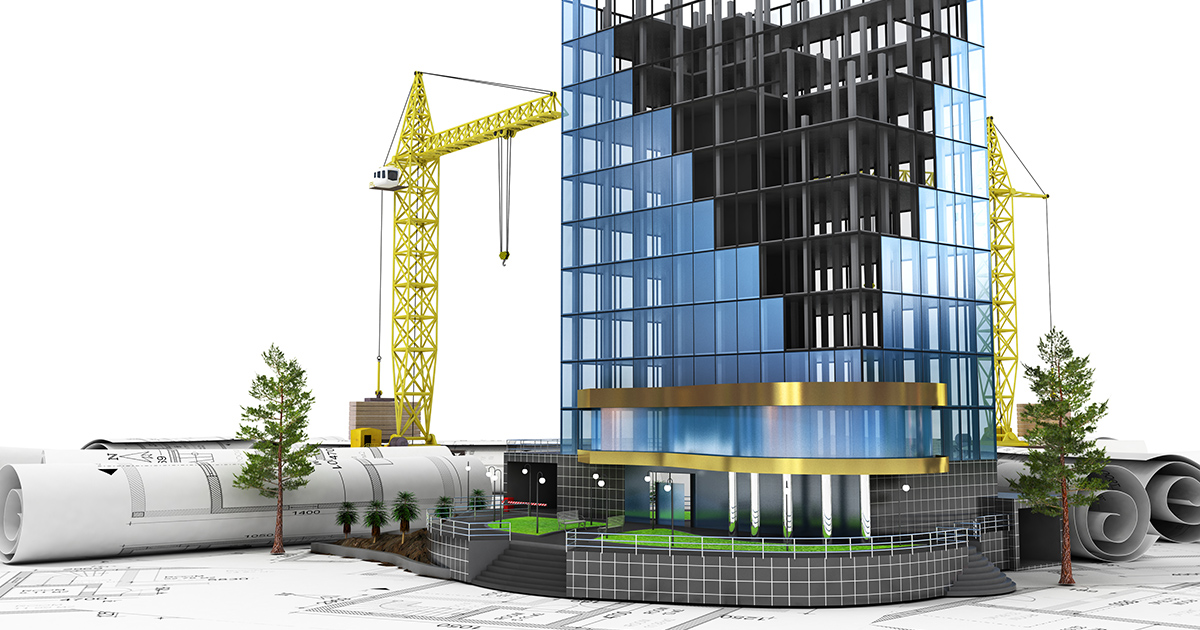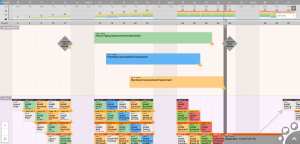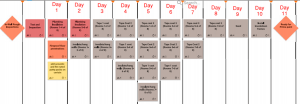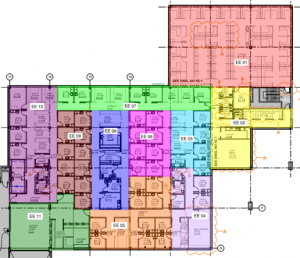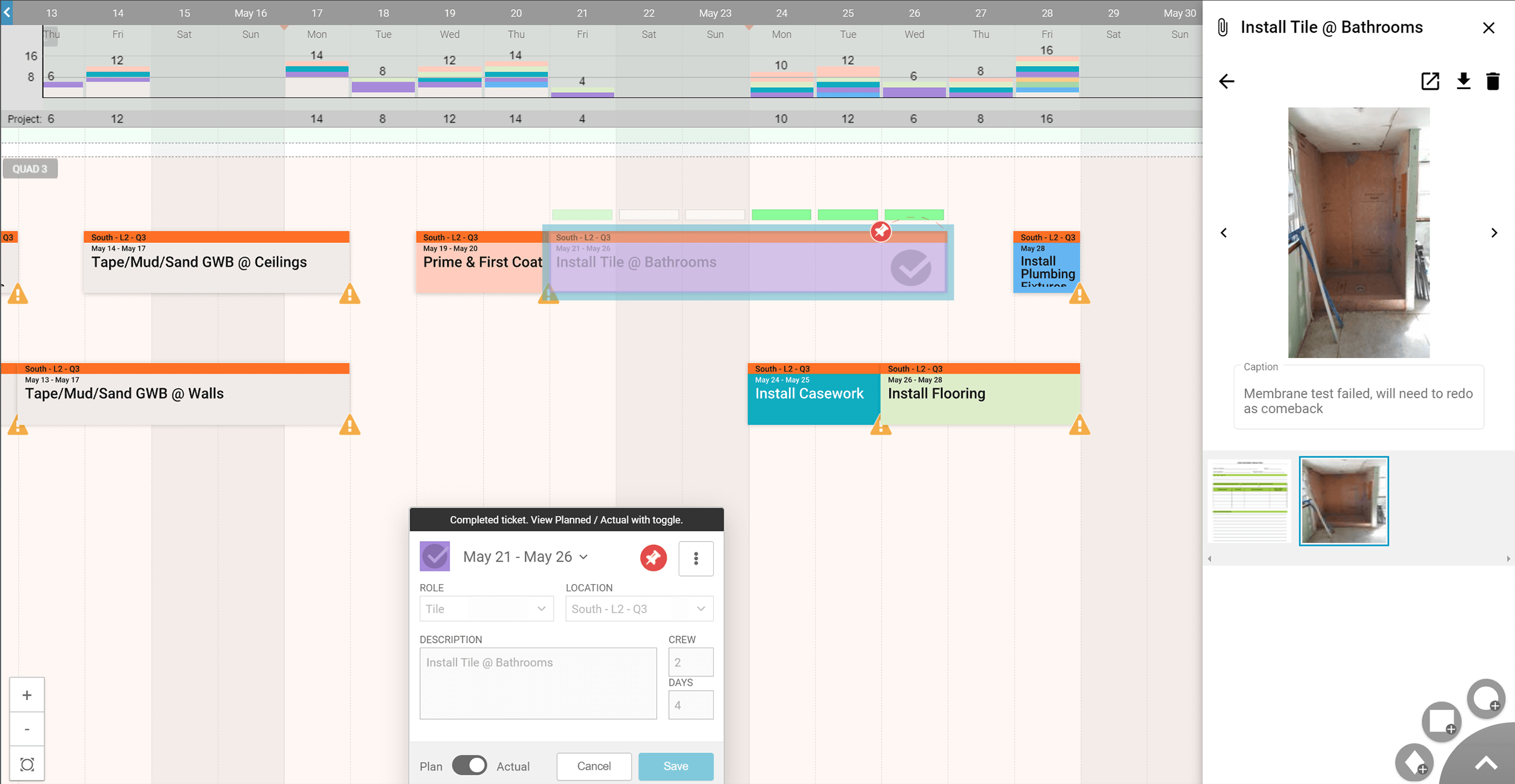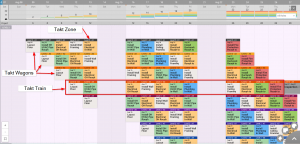(By George Hunt, Lead – Pre-Sales/Sales Engineering Touchplan and Adam Hoots, Lean Shepherd Construction ACHE Solutions) Throughout this series, we have established a background on Project Production Management, Takt planning, and several examples of how these concepts can be used to vastly improve your project results. The previous information serves as a solid foundation on how to take responsibility for your schedule process utilizing Takt planning. From this point forward, the blogs will focus on how to take accountability for executing the Takt plan. There are lots of rules and best practices that exist and others that are being established in real-time. The intention of this article is to highlight the most important ones to consider, not to be all-inclusive.
Benchmark first work in place to avoid repeating mistakes
Nothing will ruin the flow of your jobsite more than having to go back, rip out installed work, and reinstall a defective installation. This becomes amplified the longer time passes with the defective items being built on top of it. There are several ways that Touchplan teams have been able to avoid ‘go back work’:
- Understand prescriptive and descriptive expectations from all stakeholders
- Conceptual Mock-ups away from building
- Material receipt inspection
- First in place mock-up and inspection by all stakeholders
- Prescriptive and descriptive continuous inspection walks with all stakeholders
When all appropriate parties review and approve each of these opportunities for disruption, corrections can be made before the remainder of work is put in place. After this initial approval, both prescriptive and descriptive expectations will be mutually agreed to, therefore minimizing the need to redo the same work in other areas. As we bring the prescriptive and descriptive requirements to the surface, Touchplan teams can begin cautiously building to confirm their understanding of the expectations. Conceptual mock-ups are typically done away from the building and are the first step of the actual building process. Once the team agrees the mock-up is acceptable, the transition to the jobsite begins and the team does another in-place mock-up to ensure repeatability. Once the team is aligned in the field, the building begins. As the building progresses, the teams continue to involve all stakeholders with continuous prescriptive and descriptive inspections throughout the course of building.
Install: never assemble in place, never fabricate, never coat
It is becoming more commonplace to see jobs utilize offsite prefabrication, but it is still far from being the norm. If you are planning on utilizing takt, prefabrication will be a game-changer. When you move multiple steps involving raw materials and assembly from the jobsite, teams only need to install in-place. Depending on the operation, the time required on the site decreases significantly. It could mean that one trade could shift from being the bottleneck that extends the overall takt time to being faster — all with the overall takt time reduced. Prefabrication takes many of the steps that introduce variation and moves them to a controlled environment that will not affect the work on site. Do you remember Herbie from the Goal? Herbie moved much faster once his team took all the heavy items out of his backpack! This is what we are trying to do with prefabrication for the bottlenecked trade partners!
Finish as you go: no go-backs, no punch lists, no loose ends
With traditional methods of managing the schedule, we have a tendency to start activities because our CPM tells us to or we start activities to show external stakeholders that we are ‘on schedule’. Our teams are allowed to bill for progress that they have made, thus incentivizing this errant behavior. Adding work in progress only exacerbates the issues as now we have more potential for defective work and management is stretched out covering the more frequent issues that are arising. The problem is that we do not finish the same work, leaving lots of hanging threads all over the project. At some point, we will need to stop the flow of work where we are and go back to finish these areas. This mode of operating can have negative effects as we have discussed in other posts.
Adam recalls when he learned this the hard way. On a 220,000 SF dorm and dining facility at Clemson University. There were areas of work started all over the building, causing chaos and confusion as to the status of the project. When the decision was made to stop starting work and start finishing work, the project made a substantial leap forward. Seeing this in real-time helped convince the team that production laws should be always obeyed! Further understanding of Little’s Law and the law of variation have proven this to be the reason why the turnaround was so great! The decision to focus on finishing smaller batches was the best thing for the project!
Own your zone
As we discussed when starting your takt planning, the project will be broken into different takt zones and trades will systematically move their way through each zone to completion. The team must all agree on terms of what the handoff of a Takt zone is defined as meaning when a zone is handed over to you, you “own” that zone. This means that everything that happens in that Takt zone is the Zone Owners’ responsibility and that trade partner will be held accountable to ensure the next wagon receives a workable Takt zone. This also means the team will respect the other zones that have been turned over to the other trades. Here is what it means to own the zone:
- Cleanliness – Accountable to ensure the level of cleanliness is the same or better during their zone own and turnover.
- Safety – Accountable to ensure all safety hazards within each zone has been mitigated appropriately during their zone own and turnover.
- Defective (Damaged) work – Accountable to inform trade partners and/or repair damaged or defective work during their zone own and turnover.
- Finishing work – Accountable to finish their work within the Takt zone in the proper Takt time.
The handoff points become more important as we are encouraging teams to work together to be able to hand off the zone and/or accept the next zone. Ensuring clear conditions of satisfaction are key to encouraging flow from Takt zone to Takt zone. Zone acceptance inspections become critical to understand the current conditions prior to taking ownership of a Takt zone. We encourage trade partners to get a Takt zone ownership flag and move their flag with them as progress continues. This visual representation is telling the world that this zone is owned and by who! Think about the amount of pride and ownership that this philosophy is encouraging at the project site level!
If flow is to continue, accountability must be paramount to all parties involved. While planning for proper production on site is the first step, executing the work is the next. The team needs to be aware of the plan and then hold each other accountable for producing as expected. The practices described in this post serve as a starting point for you to develop a culture on your jobsite where the work is continually flowing, and the project is owned!
For more information about the value of Project Production Management, listen to our recent webinar where industry experts discuss how PPM has benefitted their projects. Additionally, we have a new webinar happening at 2 PM Eastern time on September, 22nd with our partners at Bridgit on Scheduling Risks and How to Best Manage the Causes & their Ripple Effects, which you can register for now.
Scheduling Risks How to Manage the Causes & Their Ripple Effects
